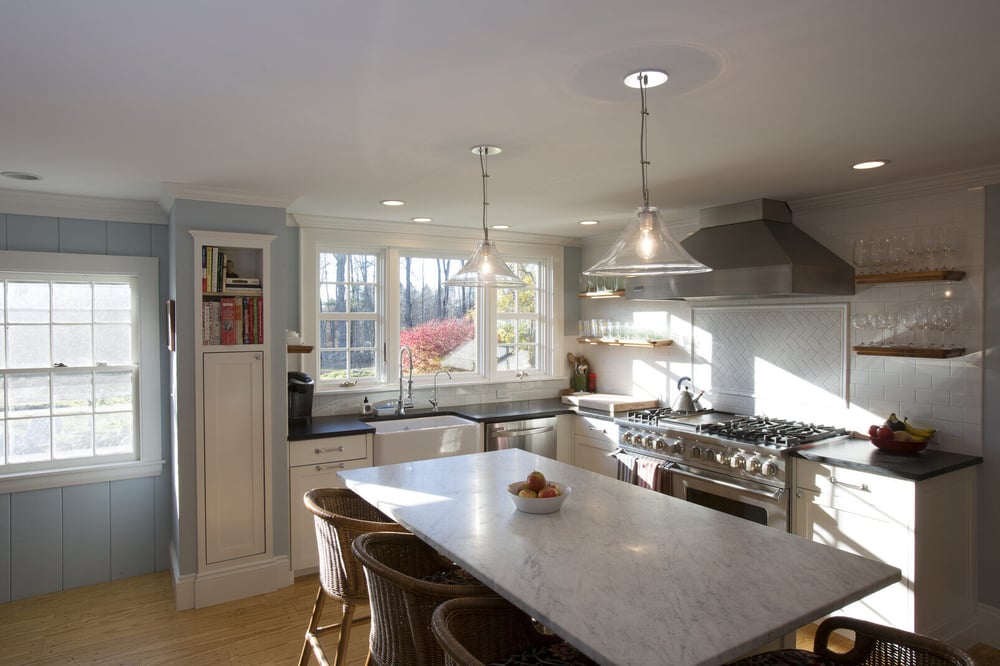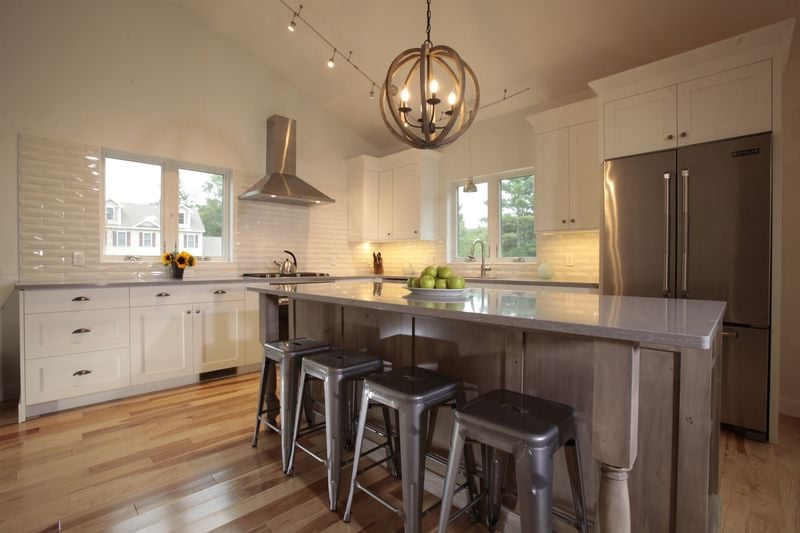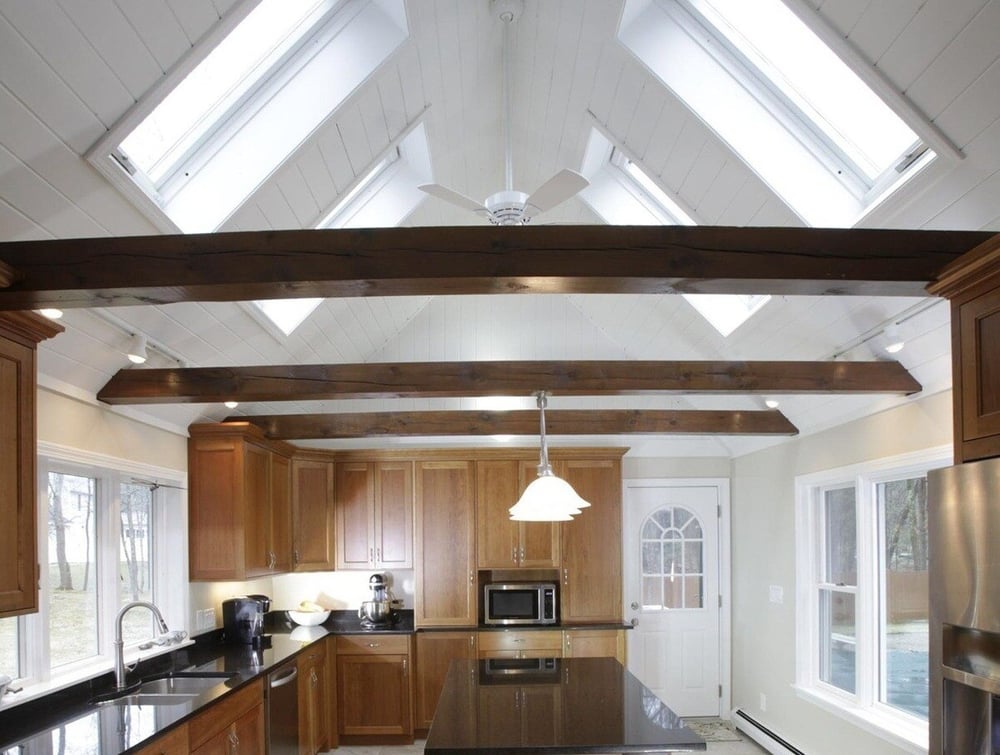6 Min Read
How Long Does a Remodel Take in New Hampshire?
If you’re thinking about remodeling your home, one of the first questions on your mind is probably:
“How long does remodeling take?”
It’s a fair question. After all, your home is your daily sanctuary, and the sooner life gets back to normal, the better. The truth is complicated. That's why it needs an entire blog post. The home renovation timeline depends on a few key factors, like the project size, the scope of work, and how much planning happens before construction begins.
Table of Contents
- How Long Does It Take To Plan A Remodel?
- Breaking Down Remodel Timelines: What To Expect For Your Project
- Avoiding Delays: Common Reasons For Change Orders & Construction Schedule Issues
- Planning A Remodel In Seacoast, New Hampshire, Maine, Or Massachusetts? Let’s Get Started!
Oxland Builders helps homeowners throughout Rockingham County, New Hampshire, Southern Maine, and Northern Massachusetts navigate the remodeling process with clear expectations, expert craftsmanship, and a streamlined design-build approach. We know that understanding the realistic timeline for your project can help you plan ahead and avoid surprises. Today, we’ll break down how long a remodel typically takes, talk about the factors that can speed things up, what can slow things down, and how to stay on track.
.jpg?width=960&height=641&name=New%20Hampshire%20living%20room%20remodel%20with%20sliding%20door%20to%20kitchen%20by%20Oxland%20Builders%20(1).jpg)
How Long Does It Take to Plan a Remodel?
The planning phase is one of the most important steps in any remodeling project. This is when you’ll make design decisions, obtain permits, and order materials—factors that directly impact how smoothly your project runs.
Oxland Builders takes homeowners through a structured design-build process to ensure everything is planned before we break ground. On average, the planning phase takes 2 to 4 months, depending on the scope of work.
What Happens During Planning?
- Initial Consultation & Vision Development (2–4 weeks) – We discuss goals, budget, and must-haves.
- Design Phase (4–8 weeks) – Floor plans, 3D renderings, and material selections are finalized.
- Permitting & Material Ordering (4–6 weeks) – We submit necessary permits and order long-lead items like custom cabinetry or specialty finishes.
Wondering what the project you have planned might cost this year? See our updated local cost information here.
Breaking Down Remodel Timelines: What to Expect for Your Project
No two remodeling projects are the same. A kitchen renovation, a bathroom upgrade, and a whole-home remodel each come with different timelines, challenges, and phases. While some updates can be completed in a matter of weeks, more extensive projects take months of planning and execution. To give you a clearer picture of what to expect, we’re breaking down the average construction timeline for kitchen remodels, bathroom renovations, and full-home remodels, so you can plan ahead with confidence.

Kitchen Remodel Timeline: How Long Does a Kitchen Renovation Take?
A kitchen remodel is a popular upgrade and a great way to change your daily experience. It is also one of the most complex rooms to remodel. With plumbing, electrical, cabinetry, and appliances all in play, a kitchen remodel requires careful planning. So, how long does a kitchen remodel take? The answer depends on the size and scope of the project.
Kitchen Remodel Time Frame by Scope
Small Kitchen Refresh (6–10 weeks)
- New countertops, backsplash, cabinet refinishing, lighting upgrades.
- No major layout changes or structural work.
Mid-Size Kitchen Remodel (10–14 weeks)
- New cabinetry, appliance upgrades, minor layout adjustments.
- May require some electrical and plumbing updates.
Full Kitchen Remodel (14–20+ weeks)
- Complete gut renovation with new layout, custom cabinetry, and new flooring.
- Structural modifications, such as removing walls or relocating plumbing.

What Affects the Kitchen Remodel Timeline?
Factors such as the following will impact even a well-planned kitchen remodel timeline.
- Custom cabinetry lead times – Custom cabinets often take 8–12 weeks to manufacture.
- Plumbing and electrical updates – If your layout changes, rough-in work adds time.
- Permit approvals – Depending on your town, permits can take weeks to months to process.
- Material availability – Special-order countertops, tile, or appliances can cause delays
Bathroom Remodel Timeline: How Long Does It Take to Remodel a Bathroom?
Bathrooms may be one of the smallest rooms in the house, but they require just as much coordination as a kitchen remodel. Between plumbing, waterproofing, tile work, and specialty fixtures, every detail needs to be carefully planned to avoid delays. Here’s what you can expect for the construction phase of your bathroom remodel.
Bathroom Remodel Construction Timelines
Small Bathroom Remodel (4–6 weeks)
- Cosmetic updates like a new vanity, flooring, fixtures, and lighting.
- No major plumbing or layout changes
Standard Bathroom Remodel (6–10 weeks)
- Full tub/shower replacement, updated tile work, and new plumbing fixtures.
Potential reconfiguration of the layout (moving a sink, toilet, or shower).
Luxury Primary Bathroom Remodel (10–14+ weeks)
- Custom tilework, spa-like features (steam shower, heated floors, high-end fixtures).
- Expanding the footprint, adding storage, and upgrading plumbing/electrical systems.

What Takes the Longest in a Bathroom Remodel?
Several key factors can impact how long your bathroom renovation takes, including:
Tile Work & Waterproofing – Custom tile showers, intricate patterns, and specialty grout can add weeks to the project. Proper waterproofing is also a non-negotiable step that takes time.
Plumbing & Fixture Relocation – Moving a shower or toilet requires new plumbing rough-ins, which adds time to the timeline.
Shower Glass Fabrication – Many glass shower enclosures are custom-made, and measurements can’t be finalized until the tile work is complete. Fabrication can take 2–3 weeks.
Custom Vanities & Specialty Features – Custom cabinetry, stone countertops, and high-end fixtures often have longer lead times.
Whole-Home Remodel Timeline: How Long Does It Take to Renovate an Entire House?
A whole-home remodel is a major undertaking, often requiring phased construction, multiple trades working in sequence, and careful scheduling to keep everything running smoothly. You're likely remodeling an entire floor or gutting a home down to the studs. These projects require patience, but the results are always worth it.
Whole-Home Remodel Construction Timelines
Here's what you can expect when remodeling an entire home.
Cosmetic Update (8–12 weeks)
- New flooring, paint, trim, lighting, and minor kitchen/bath updates.
- No major layout changes or system upgrades
Structural Remodel (16–24+ weeks)
- Removing walls, updating kitchen and bathrooms, new flooring, electrical, and plumbing.
- May involve adding beams for support and working with engineers
Full Gut & Rebuild (6–12+ months)
- Stripping the home down to the studs and reconfiguring the layout.
- Installing new electrical, plumbing, HVAC, insulation, and finishes.
- Requires extensive permitting, inspections, and phased construction.

What Takes the Longest in a Whole-Home Remodel?
- Permitting & Inspections – Structural changes and full-home gut remodels require multiple permits and city inspections, which can add weeks to the timeline.
- Phased Work – Large-scale remodels must be done in phases (e.g., framing before plumbing, drywall before flooring), extending the overall schedule.
- System Upgrades – Replacing electrical panels, updating HVAC, or relocating plumbing requires specialized contractors and extra time.
- Temporary Living Arrangements – Many homeowners need to relocate during construction, and logistics around moving in and out can impact the schedule.
Avoiding Delays: Common Reasons for Change Orders & Construction Schedule Issues
Even the most well-planned remodel can run into unexpected delays. From material shortages to structural surprises behind the walls, several factors can extend a home renovation timeline. While some delays are unavoidable, careful planning can help minimize them.
Common Reasons for Change Orders in Construction
A change order is any modification to the original scope of work after construction has started. While some changes are necessary, too many can add time and cost to your remodel.
Homeowner Changes
Mid-project design changes are one of the biggest culprits behind extended timelines. Choosing a different tile, adding extra cabinetry, or deciding to relocate appliances after construction has begun can set the project back by weeks. Even a seemingly small change—like upgrading a fixture—can require additional ordering time, contractor rescheduling, and permit revisions.
Hidden Structural Issues
Though we go the extra mile during planning, such as opening up sample sections of the wall or floor, it’s common to discover surprises once demolition begins, especially in older homes. Water damage, mold, outdated electrical wiring, or subfloor issues require additional work before installing new materials. These discoveries often mean pausing construction, adjusting the scope, and waiting on additional materials or inspections before moving forward.
Permitting Delays
Many homeowners are surprised to learn that permitting can take longer than they expected. Depending on the project scope and the town’s regulations, getting the necessary approvals could add weeks, or even months, to the timeline. Some projects also require multiple inspections throughout construction, and if an inspector isn’t available right away, work may need to pause until approval is granted.
Material Availability & Custom Orders
Supply chain issues continue to impact the remodeling industry, and materials like high-end tile, custom cabinetry, and specialty fixtures often have long lead times. If materials aren’t ordered early enough, the entire project may have to wait for them to arrive. Even standard materials can go on backorder, leading to substitutions or re-selections, which can cause additional delays.
Weather & Site Conditions
If your remodel includes exterior work, New England’s unpredictable weather can sometimes impact the schedule. Heavy rain, snow, or freezing temperatures can slow down projects involving roofing, foundations, or siding. Even interior projects can be affected if materials, like drywall or flooring, need specific humidity or temperature conditions for proper installation.

How to Keep Your Remodeling Project on Schedule
While not every delay can be prevented, you can take proactive steps to help your remodel stay on track.
Make All Major Design Decisions Before Construction Begins
One of the best ways to avoid timeline disruptions is to select all finishes, layouts, and materials before any work starts. Changing your mind mid-project may seem like a small adjustment, but even something as simple as swapping a light fixture could require rewiring or new junction boxes, leading to extra work and rescheduling trades.
Order Materials as Early as Possible
Custom cabinetry, countertops, and specialty items often have 8–12 weeks lead times or more. To prevent your remodel from being stalled while waiting on materials, it’s best to order these items well in advance. An experienced builder will help you plan around these timelines, ensuring that materials are on-site when needed.
Work With an Experienced Design-Build Team
A design-build firm like Oxland Builders helps streamline the remodeling process by keeping everything under one roof. This reduces miscommunications, minimizes back-and-forth between different contractors, and ensures a more efficient workflow. By having the design and build teams collaborate from the start, potential issues can be spotted early and addressed before they cause major delays.
Be Realistic About the Timeline
Every remodel comes with some level of unpredictability, so it’s important to factor in buffer time for unexpected hiccups. While an experienced team will do everything possible to keep things on track, setting realistic expectations will help homeowners feel more prepared if minor delays arise.
Planning a Remodel in Seacoast, New Hampshire, Maine, or Massachusetts? Let’s Get Started!
A well-planned remodel is the key to a smooth and efficient process. Oxland Builders specializes in design-build remodeling across Rockingham County, NH, Southern Maine, and parts of Massachusetts, ensuring every detail is thoughtfully planned and expertly executed.
If you’re ready to start your project, let’s talk timelines and possibilities! Contact us today to schedule a consultation and take the first step toward your dream home.





